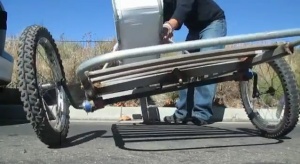~iLean
Concept
inexpensive leaning trike solution (iLean) for python and other FWD bikes/trikes.
Design
To lean, the wheels need to move in opposite direction, so either a rocking beam or leakages are needed to make this happens... Rocking beam rear suspension can be made from bottom bracket, crank, and pedal axles. Cranks and Pedal axles are good enough for a person to stand on; assuming that the wheels are strong enough, the assembly should be able to handle one person's weight.
Benefits:
- if one wheel slips, the other may still have traction
- ability to absorb bumps, only 1/2 transferred to frame, one wheel at a time (over speed bumps)
- as track gets wider, it's harder to fall (just bottom out)
- lockable for stability/convenience at rest, and easier start for beginner...
Build
Donor wheel and pedal axles are cut and welded together. There is some tolerance issue (loose) between the pedal axle and inner wheel bearing , which will lead to wear issue as found by minibulldesign. Some machining is required for better fit...
With a 16in donor bike, the track comes out to about 12 inch. Bigger donor bike should yield wider track. The BB can be cut and stretched for wider frame / cargo bed.
Test
Ride is quite similar to a bike, more grip, more resistance, less bumpy, less fear...
Testing on loose gravel has been very encouraging. Traction loss with narrow track is delayed, so recovery to upright position is possible.
Riding a wider track at full tilt (limit) was done on purpose, to simulate loss of balance and recovery by pushing harder on the pedal into the turn to get a boost of seat rise effect (at 0:17), quite natural but not so intuitive. Skidding on gravel (snow), the trike can suddenly tilt from one side to the other like a bike in trouble, except it keeps going at full tilt until recovery...
Analysis
- Steve Nurse did quite a bit of analysis for his HUPI Dec 2013 paper.
- Motion simulation shows that shorter cranks are better at smaller bumps while longer cranks are better at larger bumps. Larger wheels alone are not necessary better, but rather the flattened motion transferred to frame/seat that dictates smoothness of the ride... Below are favorable configurations:
| crank | wheel | bump | transfer |
| 4" | 12" | 1" | 16% |
| 4" | 16" | 1" | 8% |
| 4" | 20" | 1" | 5% |
| 4" | 24" | 1" | 11% |
| 4" | 28" | 1" | 15% |
| 5" | 12" | 2" | 9% |
| 5" | 16" | 2" | 15% |
| 6" | 16" | 2" | 13% |
| 6" | 20" | 2" | 8% |
| 6" | 24" | 2" | 6% |
| 6" | 28" | 2" | 10% |
| 7" | 16" | 3" | 6% |
| 7" | 20" | 3" | 7% |
| 7" | 24" | 3" | 12% |
| 7" | 28" | 3" | 16% |
Other examples
- Cargo trike with wider track
- Utility trike with bigger front wheel and some cargo capability
- TILTING TRIKE by S.Alexander Petraj
- Leaning Wooden Recumbent Trike by Steve Nurse
- Cruzbike TTrike prototype, with iLean module built/designed by Steve Nurse
- Tilting FWD delta trike by OzzySmurf
- Leaning Scooter Concept by Coenraad Erasmus
Links
Vi, Futon Express, Bango, Flintstones, μPython, Mini Python, Guinea Pig, Bipolar, FP02, FS24P, iLean


